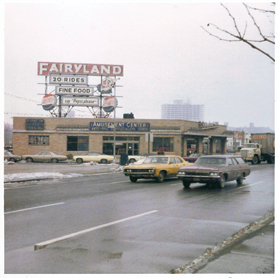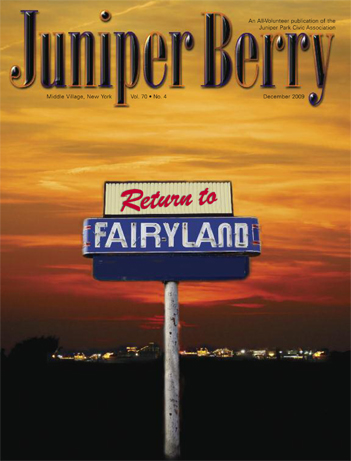Let’s start with a tried and true, “Once Upon a Time in Fairyland –
An unorthodox approach in the framing, presentation and operation of a Kiddieland Park paid big dividends for investors Bernard Berkley and his partners in the development of Fairyland, Queens. It started operations in 1949 a few blocks away from where it officially settled in 1950 on Queens Boulevard and 57th Avenue. By 1953 that spot was credited with being one of the most successful in the nation dollar wise, with an estimated gross of about $250,000 annually.
The establishment of Fairyland came about more or less accidentally, since it was a second choice undertaking after plans to erect a huge coliseum fell through.
The arena plans were formulated a couple of years after WWII when the Ringling Bros. Barnum & Bailey Circus and Madison Square Garden were wrestling over contract terms in renewing a long standing pact. For a time it looked as though the circus would be happy to move elsewhere if suitable housing were available at a savings, and it was with this in mind that Berkley and his associates gave serious thought to the construction of the new, mammoth showplace. But, the story goes, while the other major arena attractions needed to keep a big house busy and were receptive, they wanted too much to say considering the fact that they would have no share in the cost of the structure.
It is the location that is of paramount importance, Berkley and his manager, Al McKee, claimed. Fairyland is located on Queens Boulevard at the intersection of Woodhaven Boulevard and is accessible by foot, automobile, bus and subway. The subway station is within a block and the first sight to greet the people as they climb to the sidewalk is the Park’s Ferris Wheel.
The Park is located on a plot measuring 250 feet by 600 feet and represents a total estimated investment of about $300,000, which was a sizeable gamble in a strange business for the uninitiated, as Berkley and his partner, McKee, were believed to be. But the fun spot clicked from the start in ways they never anticipated. While it was naturally hoped that the project would be successful, no one had any way of knowing it was located in the heart of a business hub that developed into an ideal source of customers.
People who live in the Elmhurst area for several miles around Fairyland earned incomes that allowed them to pay up to $150 a month for apartments. That meant that they were sufficiently well off to spend a dollar or two on entertaining their children just about any time they wanted to or wherever the youngsters managed to talk them into going!
When it opened, the Park contained 14 ride units in addition to a restaurant and penny arcade. By the 1960’s the park expanded to 20 then 24 rides by the time it closed. The rides included a large Merry Go Round and kiddie Merry Go Round, Sky Fighter, Jeep & Water Boat ride, a Whip, a Pony Cart and Dry Boat ride an Auto Fire Engine and little Ferris Wheel, a Train, a baby Turtle and a No. 10 Ferris Wheel.
There were no shade trees or water other than drinking fountains or any other recreational refinements other than benches along one fence. This design was intended to hold the people in the Park after they had spent their money or interest in the rides. You see how developers got into people’s habits even as far back as 55 years ago.
McKee pointed out that the turnover aspect was important at the Park as it must be at all Kiddielands operating in restrictive premises. The Park patronage at Fairyland was reported to run as high as 15,000 people on good Sundays at the height of the season.
Fairyland was fortunate to have ample parking. Ample parking made quite a difference in the gross and the Berkley/McKee spot had 5 lots, all paved, capable of handling 3,000 to 4,000 cars on a Sunday.
The price schedule was the same seven days a week. Single tickets, good on any ride, were priced at 14 cents and were good for adult or child admissions. The Park also peddled a $2.50 season book of tickets containing 28 tickets or enough to take a youngster around the Park twice.
The Park management was not much interested in cut-rate deals. To begin with, business was excellent and there was no particular reason to lean over backwards in offering price inducements to groups. McKee was of the opinion that bargain days actually drained on the good days.
The Park spent an estimated $40,000 on advertising in the course of a year. Most of the money went into billing, with two streets being used extensively for bus and subway advertising.
McKee pointed out that Fairyland showed no evidence of suffering from the competition of the estimated 20 other Kiddielands located on Long Island. There were apparently enough people to go around.
The Park opened at 10am and continued until 10pm each day during the season. On particularly hot nights, the Park stayed open to 11pm when the power was then shut off.
The Roller Coaster was the most popular ride in the Park but didn’t earn the biggest gross because it lacked capacity, riding only 12 patrons at a time. The Train, with a capacity of 48, did the biggest business on the best days because it could handle the most riders. On slow or normal days the Merry Go Round, with its 32 horses, earned top money. The teenagers gave the larger units a good play and it is estimated that the Coaster, Ferris Wheel and Train patronage was made up of about 20% adults.
Since Fairyland was located in NYC there were some special operating problems that most Kiddielands throughout the country did not face. To begin with, no operator could be under 21 years old. That age excluded most college students, a group that might otherwise contribute highly desirable personal and intelligent help. In addition, all operators had to be licensed. City inspectors were on the constant lookout for violations.
On weekdays it took from 20 to 24 persons to operate Fairyland. Saturdays the total jumped to 25 to 30 and on Sundays as many as 30 to 34 persons. Help was plentiful with most of the operators otherwise employed and interested in the extra work to earn extra dollars.
The popularity of Kiddielands and Fairyland in particular amazed McKee and Berkley even though their experience in the business was vast, covering virtually every phase of outdoor show endeavors.
The Kiddieland or special sections McKee recalled were long considered a necessary evil at major park installations. While operators everywhere had attributed proper stature to Kiddieland operations, the separate units located close to highly concentrated population centers continued to siphon off the cream of the moppet business. McKee stated that Fairyland, only a little more than two years old at the time, was
a good example.
The end of Fairyland
Fairyland was closed in 1968 to make room in 1973 for the Queens Center Mall. This mall reportedly made more money per square foot than any other mall in the country. In 2002 the Mall underwent a $275 million expansion to a total of approximately 1,000,000 square feet and boasted a clientele with incomes at a level to support the massive expansion.
A word about the Queens Center Mall, located at the site of what once was Fairyland, shows that it has a dominant position in its trade area, while maintaining its long-time status as one of the most productive malls in the entire United States. It speaks to the foresight of Berkley and McKee when they gambled on “Fairyland” because of the location at the hub of everything good in Queens County.
Who knew back in the late 1950’s and into the 1960’s that while our kids were enjoying the Kiddieland rides in Fairyland they were at the epicenter of business, riding into the future prosperity of the Borough of Queens?
When Berkley and McKee looked at the site back in the early 1950’s and saw it as the ideal site for their Fairyland, they acted on the most important tenets of real estate; location, location, location! It never ceases to amaze me how creative and productive a person can be when left alone to figure things out for himself or herself, no government stimulus packages, no handouts!
Fairyland Kiddiepark is a classic example of two entrepreneurs, Berkely and McKee, doing the American thing, seeing a need and all its possibilities, and acting on it! They were among the early pioneers, no question, to the tune of making a whopping $250,000 a year!
There you have it, I hope you find this article as interesting as I did writing it. The history of our neighborhood and how it evolved into what it is today is fascinating. What is even more fascinating to me is that many of us who came here at its birth, when it was surrounded by farms, are still here, some in spirit, because their kids have stayed, seeing the future “possibilities” of our great location, location, location! Our neighborhood is the epicenter of everything good with a future that continues bright.
It’s time to return to 2009, after 40 years, I hope you enjoyed your visit to Fairyland. It was sure great seeing her again!




